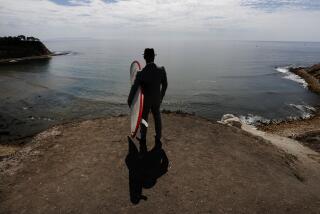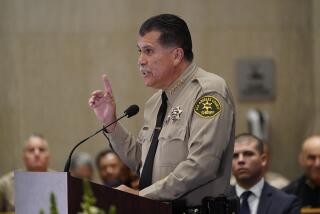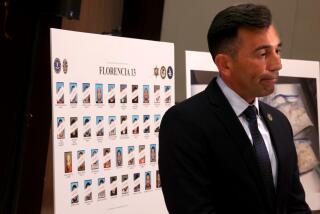Latino Gang Members Sign Truce Pact : Treaty: The men, meeting in a Santa Ana park, agree to lay down their weapons.
- Share via
SANTA ANA — About 500 Latino gang members from across Orange County gathered in El Salvador Park on Saturday to sign a treaty codifying a truce started in January.
Men from Santa Ana have been meeting regularly for months to encourage peace among rival gangs. On Saturday, representatives of three dozen gangs from San Clemente to La Habra joined the talks, promising with their signatures to lay down their weapons and stop the violence. Men who support the treaty say future disputes will be settled by fistfights or through sports rather than with guns and knives.
“We know that paper’s just paper, but it’s the one that signs the paper that lives by it,” said Gilbert Gonzalez of the Santa Ana-based United Gangs Council, which organized the summit.
“We can make it a lie or we can make it alive,” Gonzalez told the crowd of young men. “You’re living the peace right now.”
The United Gangs Council for the past eight months has been organizing summits in the park and canvassing neighborhoods to promote a verbal truce among rival gangs.
Council members say gang activity has dropped significantly, and that the formalized treaty will mean ostracism and retribution for anyone who breaks the peace.
Santa Ana police say that violence in that city has decreased recently, although there have been more gang-related homicides this year than last. There have been 14 such killings since the truce began in January--the most recent July 27--compared to 13 in all of 1991, according to Lt. Bob Helton.
“The gang shootings have not stopped, although there don’t seem to be as many as in the same period last year,” Helton said Friday. “Anytime you have a group of individuals who are willing to take some steps to reduce criminal behavior, that to me is a positive move.”
Saturday, gang members as young as 13 came to El Salvador Park on bikes and in trucks, shaking hands, slapping backs and calling one another “homeboy.”
With white T-shirts covering tattoos that declare hometown, gang affiliation, nickname or girlfriend, the gangs stood in factions around the park, drinking beer and smoking cigarettes, until the leader of the gang council beckoned.
“This is a historic moment, homeboy,” said Pete Ojeda, a 50-year-old Santa Ana man who joined a gang when he was 16. “It’s something that we all want,” Ojeda said before he read the treaty aloud. “All the killings of innocent people, it’s not necessary.”
Written in script on white poster board, the treaty talks about the repercussions of drive-by shootings, warns that anyone who breaks the truce will be treated “as a child molester, a rat, a rapist, which all mean a coward,” and declares the importance of racial unity.
“To gain our communities’ trust and support we must change our violent ways,” the document says. “Our word is the only good thing we have to make this work.”
About 50 individuals signed the treaty, but some were concerned that they would not be allowed to fight back if attacked, while others said they simply did not believe the truce could work.
“We’ve been at war for over 20 years. We’re fourth-generation gang and they haven’t forgot,” said Jaime Pardo, 20, one of about 30 people from a Fullerton gang that did not sign the treaty. “There’s no way everybody can get along with everybody. Maybe everybody can get along with somebody, but not everybody.”
But Bobby Loco, 34, a veteran gang member from Placentia, said the time had come to end the fighting.
“We’ve got to stop killing each other, we’re brothers in blood,” Loco said as the younger men around him nodded in agreement. “Respect is the bottom line, man. Respect each other is what we’re trying to do.”
More to Read
Sign up for Essential California
The most important California stories and recommendations in your inbox every morning.
You may occasionally receive promotional content from the Los Angeles Times.










